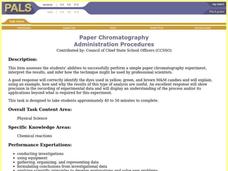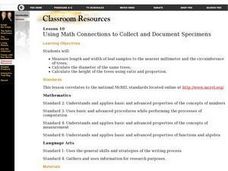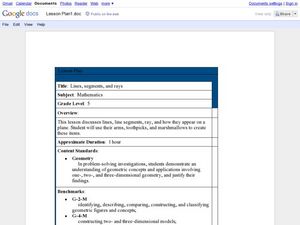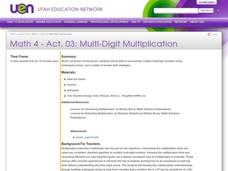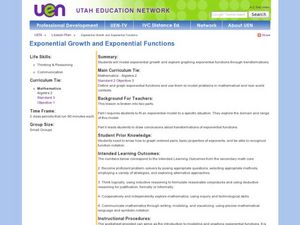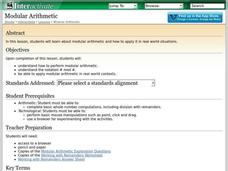Curated OER
Heating Crystals
Students examine the effects of heating on various crystals. They answer questions in the observation category which assess their ability to use a variety of senses to observe data in a certain way- a scientific way.
Curated OER
Hexagon Island
Students identify different polygons. In this geometry lesson, students name polygons using the number of sides. They calculate distance and slopes using the correct formula.
Curated OER
Tractor Construction
Students working in small groups will build tractors. They must design a tractor that is able to pull various weights.
Curated OER
Prime and Composite
Sixth graders practice implementing manipulative's to assess composite and prime numbers. They formulate representations of rational numbers in a variety of ways including graph paper, sieves of Eratosthenes and multiple worksheets.
Curated OER
Paper Chromatography
Small groups of students perform paper chromatography to separate food dyes into their component colors. Students perform the experiment and collect, organize, and represent their data to form an explanation of their outcomes. Students...
Curated OER
FOILing
Students practice using the FOIL acronym as a procedure for multiplying two binomial expressions. FOIL occurs by multiplying the First terms, Outside terms, Inside terms and Last terms.
Curated OER
Using Math Concepts to Collect and Document Specimens
Students determine the length and width of leaf samples to the nearest millimeter and the circumference of trees. They participate in a discussion about the importance of collecting specimens carefully. They compile accurate...
Curated OER
Sorting Quadrilaterals
Tenth graders investigate the geometric concept of quadrilaterals. They are given a set of shapes and asked to sort the quadrilaterals from the others. Then working in pairs they discuss the characteristics and write down the description...
Curated OER
Let the Matrix Do It
Learners create a matrix of the vertices of a triangle and produce new matrices that dilate, translate, rotate, and reflect the original triangle. After multiplying each matrix by a new scale factor, they graph the new matrix and...
Curated OER
Lines, Segments, and Rays
Fifth graders use their arm, toothpicks, and marshmallows to create lines, segments, and rays. In this lines, segments, and rays lesson plan, 5th graders learn how these appear on a plane.
Curated OER
Differentiate Elements, Compounds, and Mixtures
Pupils examine the differences between elements, compounds and mixtures. Using diagrams, they compare and contrast atoms and molecules and describe various chemical reactions. They distinguish the differences between ionic and covalent...
Curated OER
Math Quilts
Students examine geometric shapes. In this geometric shape lesson plan, students examine how geometric shapes flip, turn, and slide to create a pattern. Students analyze the role that quilts played in helping slaves escape to freedom. ...
Curated OER
Threads
Young scholars group observed data, filtering from all their observations the similarities between burring threads. In the second part they make a comparison of a chosen attribute between the two threads.
Curated OER
Exploring Multiplication and Division at a Party
Students solve multiplication and division problems using Unifix cubes. They explore multiplication and division through equal grouping of objects and sharing. Students discuss the task they completed and share how they completed the...
Curated OER
Multi-Digit Multiplication
Fourth graders practice mastering the ability to multiply multi-digit numbers utilizing rectangular arrays and a variety of mental math strategies. They model and illustrate meanings of multiplication and division of whole numbers and...
Curated OER
Exponential Growth and Exponential Functions
Students explore the concept of exponential functions. In this exponential functions lesson, students model exponential growth about a high school population using an applet. Students manipulate the applet to show the effect that a...
Curated OER
Design a Better Classroom Workplace
Students design a new classroom workplace. In this architecture lesson, students use area formulas to identify the problem with the existing desks in their classroom. Students design their own solution volume formulas to solve the...
Curated OER
Rubber Band
Eighth graders investigate what would happen to the length of a rubber band as more and more rings were hung on it. They base their explanation on what they observed, and as they develop cognitive skills, they should be able to...
Pennsylvania Department of Education
Adding and Subtracting Three-Digit Numbers by Jumping
Second graders use data to graph information and draw conclusions. In this lesson on data analysis, 2nd graders practice gathering, sorting, comparing, and graphing data. Students differentiate data that can and cannot change over time.
Curated OER
Fraction of a Number
Pupils explore how to multiply fractions using color tiles. They use the appropriate strategies for the multiplication of fractions. Students use 40 color tiles to practice multiplying fractions. They practice using various fractions to...
Curated OER
The 3R's: Rights, Rules, and Responsibilities
Eighth graders complete seven work stations that highlight math activities while they focus on the rules for Internet use and classroom rules for working in cooperative groups. After completing the activities, they complete a self-...
Curated OER
Modular Arithmetic
Students investigate modular arithmetic and how to use it to solve real world problems. In this modular arithmetic lesson, students use computers to work on modular arithmetic after a teacher guided lesson. They complete guided practice...
Curated OER
Investigating: Finding the Volume
Sixth graders explore geometry by utilizing colored cubes in class. In this volume lesson, 6th graders identify the different shapes they can create using their colored cubes and identify the formula for finding volume. Students create...
Curated OER
Similar Triangles
Ninth graders find the height of every day objects using techniques learned through postulates that allow triangles in a problem to be similar. They calculate the length of a missing side and solve proportions.




